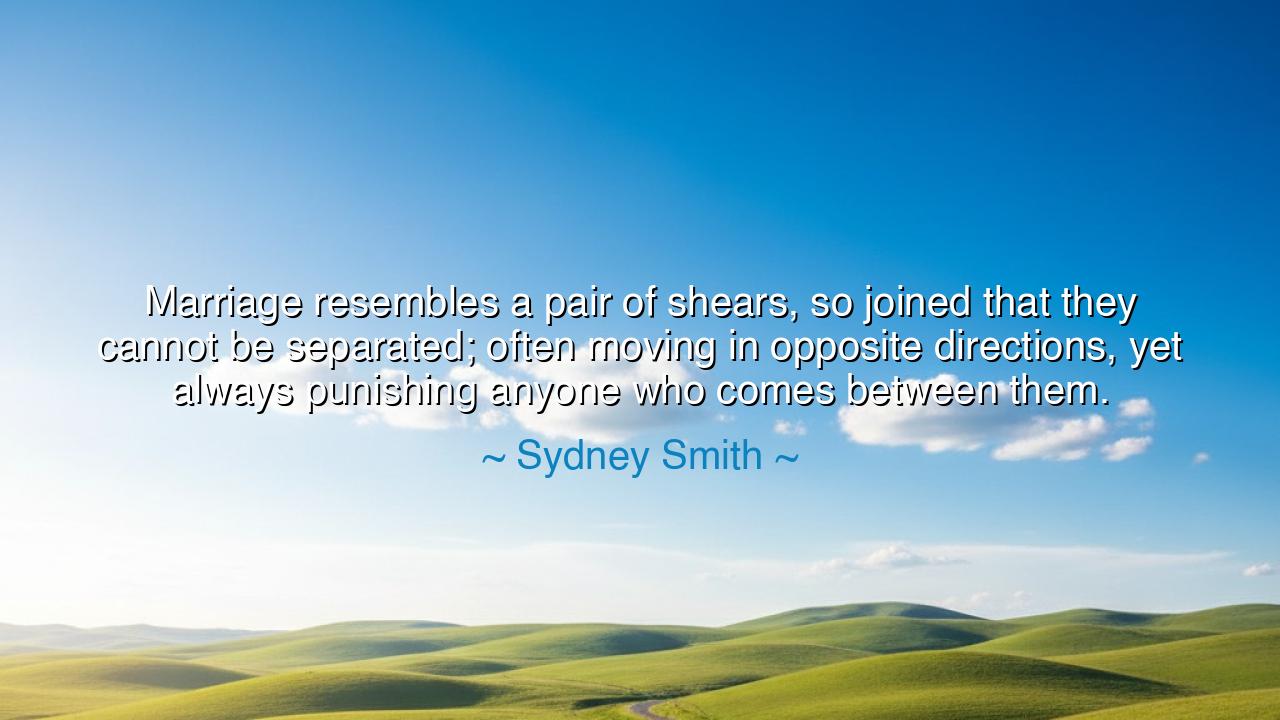
Marriage resembles a pair of shears, so joined that they cannot
Marriage resembles a pair of shears, so joined that they cannot be separated; often moving in opposite directions, yet always punishing anyone who comes between them.






The English clergyman and essayist Sydney Smith, with wit sharpened by wisdom, once spoke of marriage in this way: “Marriage resembles a pair of shears, so joined that they cannot be separated; often moving in opposite directions, yet always punishing anyone who comes between them.” In these words, lighthearted though they may appear, is hidden a profound and ancient truth about the bond of marriage. It is a union forged so tightly that even when its parts move apart, they remain bound, working as one. And in their union lies a warning: any who dare intrude between husband and wife find themselves wounded by the very strength of their bond.
The meaning of this metaphor is rich. Like shears, marriage is composed of two distinct beings, each with their own path, their own movements, and sometimes their own contradictions. At times, spouses may appear to move in opposition—different desires, clashing tempers, diverging thoughts. Yet their strength lies not in sameness, but in their joining. Though they diverge, they are held together by a central bond—commitment, covenant, love—that makes their opposition fruitful rather than destructive. For just as two blades only cut when they move against one another, so too does marriage often find its power in the tension of difference.
Smith also reveals the protective nature of marriage. He writes that the shears punish anyone who comes between them. This is no small truth. A true union is guarded fiercely. Outsiders who meddle, who seek to divide, who drive wedges between husband and wife—whether through gossip, temptation, or malice—will find themselves caught in the sharp edges of their bond. The covenant of marriage is not merely private affection, but a shield against intrusion. When honored rightly, it defends itself with strength, cutting away all that threatens its unity.
History offers us living testimony of this. Consider the marriage of John Adams and Abigail Adams. They lived much of their married life apart, John away at the Continental Congress, then in Europe as a diplomat, while Abigail managed the farm and raised their children at home. Often they moved in what seemed to be “opposite directions.” Yet their correspondence—hundreds of letters exchanged over decades—shows that they were bound inseparably, each sharpening and strengthening the other. Outsiders might have tried to sway them, but their bond was unyielding, punishing any attempt to divide their loyalty. Their marriage, like shears, cut powerfully through the trials of history, joined always at the center.
The deeper wisdom in Smith’s words is that marriage is not a fragile harmony of identical wills, but a strong joining of distinct ones. It is precisely because the two are not the same that their unity has purpose. A single blade cannot cut; it is useless without its partner. So too, a solitary will cannot create the fullness of marriage. Only in the tension, the friction, the joining, does life’s work get done. And in this lies both the beauty and the burden of the bond: to be joined inseparably, even when moving apart.
The lesson for us is clear. Do not fear the differences within your marriage, nor despair when you and your spouse move in opposite directions. Remember that the strength of marriage lies not in sameness, but in unity of purpose, in the joining that holds firm through opposition. Guard your marriage against intruders—be they pride, infidelity, or the idle meddling of others—for what comes between you will find itself wounded by your fidelity if you remain true. And above all, honor the bond at the center, for it is what transforms two blades into one pair of shears, useful, purposeful, and enduring.
Practical wisdom flows from this: speak openly with your partner, respect your differences, and remain joined in loyalty. When quarrels arise, remember that the central rivet of your bond—your vows, your covenant—holds you still. When outside voices tempt you to divide, turn instead toward one another. For a marriage rightly lived is like shears: inseparable, purposeful, and sharp against all that threatens its peace.
Thus let the words of Sydney Smith be carried to future generations: “Marriage resembles a pair of shears.” For in this playful image is hidden a truth heroic and eternal—that the power of marriage lies not in erasing difference, but in joining difference so tightly that no force from outside can ever divide it. And in such a union lies strength enough to shape the world.






AAdministratorAdministrator
Welcome, honored guests. Please leave a comment, we will respond soon